
A few weekends back we hopped a boat across Amatique Bay to the town of Livingston, Guatemala. The trip was timed to coincide with a three-day holiday weekend and our visa renewal, given that it costs US$25 any time you want to leave Belize (and the same to renew).
While only about 20 nautical miles away from Punta Gorda, Livingston feels like another world. On the surface, contrasts are obvious: Spanish-colonized country versus British; English vs. Spanish. Yet, there’s more to it than that.
PG has the feel of a lazy forgotten fishing town on the way to nowhere, and in fact it is the southern terminus of the Southern Highway in Belize; beyond PG, only the Caribbean. The British didn’t invest much in Southern Belize — infrastructure or really anything else for that matter — and the Belizean-run government seems to have continued the tradition. In fact, as recently as five years ago, much of the highway leading into PG had not yet been paved.
Livingston, on the other hand, was a central trading hub for centuries, and Guatemala’s chief sea port up until the construction of neighboring Puerto Barrios. Guatemala was considered the jewel in the crown of Spain’s influence in Central America, and Antigua was its cultural epicenter. As a result, the Spanish invested much in terms of road and sea linkages in the country and the results are evident in Livingston long after its heyday and in spite of its water-locked geography (even today, you can only get to/from town by boat).
Despite their differences, the two sister cities are tightly bound and share deep roots. Geographically, both sit on opposing sides of the Amatique Bay in the Gulf of Honduras, and receive the same weather systems (they are only 20 miles apart, after all). Both places were primarily settled by Garifuna people, but today are a mix of a variety of cultures and ethnicities.

[This is a big step for me — dotted and curved lines in Photoshop — seems like it should be easy but in reality it is quite a process!]
The above map shows Punta Gorda, Livingston and Puerto Barrios in the context of one another surrounding Amatique Bay. On Sunday, we took a day trip to Playa Blanca, which is also listed above. Playa Blanca is a beautiful place and actually very close to Belize, but you wouldn’t necessarily be able to charter a boat directly given that you’d have to pay immigration a visit first at Livingston or Puerto Barrios — though I’m sure if you found the right boat captain and were lucky enough to avoid immigration officers you could probably swing it…but somehow I don’t think that would be a very smart idea.
One of the most striking things you immediately notice when approaching the Guatemalan coast from Belize is how dynamic the coastline is. While the Maya Mountains are visible in the far west in Belize, most of the area along the coast is as flat as a banana pancake. However, in and around Livingston, everything’s built on jungle-covered hills and sheer cliffs jutting into the sea. Coconut and banana trees sway in the wind (PG’s got these, but it’s different). Arriving into PG by boat is pretty ho-hum. Arriving into Livingston is like arriving in an idyllic Caribbean jungle port town, and, dare I say, a bit magical?

Around Livingston
[Above] Christ welcomes you as you enter the mouth of the Rio Dulce and Livingston Harbor — perched atop his own little grassy island beside an uncomfortable looking concrete bench (just to the right of the island) for anyone who wants to take a load off (and get a sea bath while they’re at it).
Now, in the interest of full disclosure, about 80% of the photos in this post were snapped by Lori, and she did a wonderful job, might I add. I opted not to take my behemoth of a camera on this trip, but also had no idea that Livingston would be so photogenic. But that’s one of the beauties of living in Southern Belize for an entire year — there’s a good chance we’ll be back to Livingston!
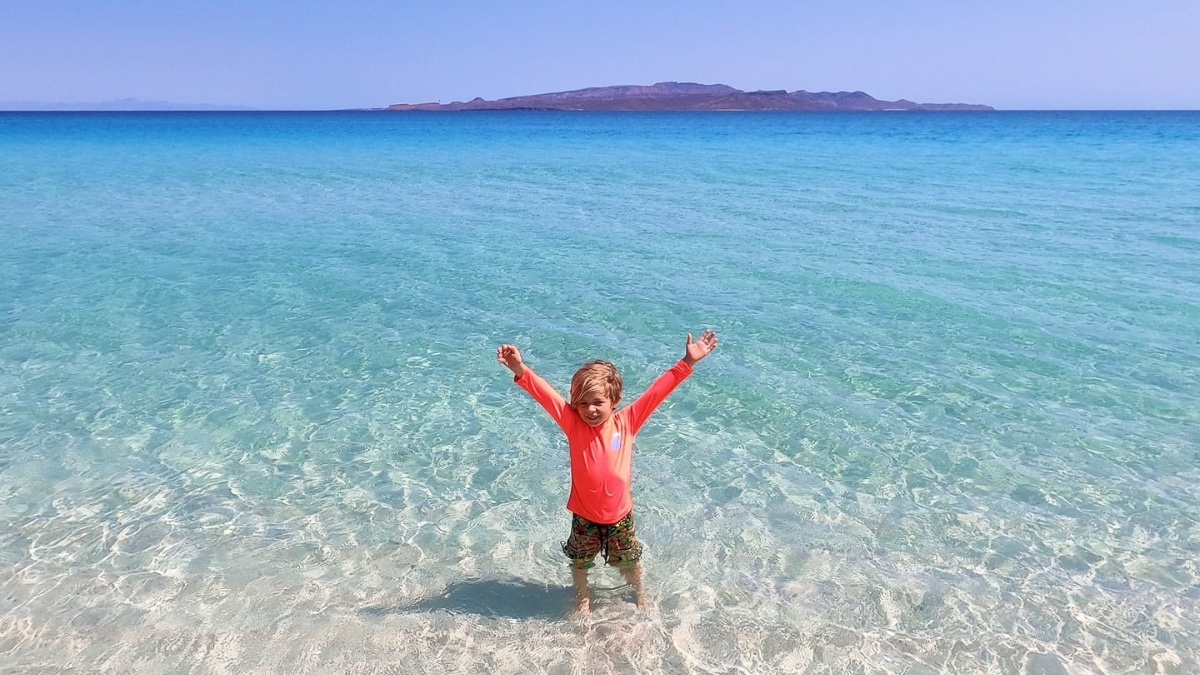

Garifuna people taking a cruise/swim on a traditional boat.

Garifuna girl swimming under the watchful eye of Jesus. The mountains viewable in the distance are actually the Maya Mountains. Believe it or not, PG is about half way between here and there.
As you can also tell from the photo, the waters around these parts can get a little rough. We actually had a slightly rough crossing coming over to Livingston, which we gathered was not usual. The boat was a decent size (and loaded down with several cases of whiskey), so we never felt we were in danger (a good captain never does anything to jeopardize the whiskey…provided that you have a good captain, of course!). But 45 minutes of plowing through and jumping off whitecaps at high speed (propelled by two 105HP motors) over a black and silver sea is surprisingly fatiguing — Lori likened it to a 45-minute roller coaster ride, but I don’t like roller coasters and found most of the crossing to be more than tolerable, though it did do a number on my hair. A big part of the reason for the rough seas was the time of day, as we departed around 4:30p and the wind always kicks up in the evening.
For the record, the crossing back to Punta Gorda at 2pm on Monday was baby-butt smooth.
If you’re looking to get from Punta Gorda to Livingston, reliable information is a bit tricky to come by because schedules are always changing and there are always exceptions to the rule. Consequently, I’m not even going to attempt to lay out the boat schedule. The most commonly-cited schedule is at Hickatee.com, which essentially presents what is written on the board at the boat dock in Punta Gorda. It says that Memo’s runs every day, which we found simply not to be the case. We haven’t heard of half of the companies listed on there, but can say with some certainty that Shark Boy makes the trip every day to and from Puerto Barrios (60 minutes), from which point you can take a boat to Livingston which runs every 30 minutes or so (both directions) and takes about 30 minutes. We ended up taking a special charter to Livingston direct, arranged through a friend, but took the Livingston => Puerto Barrios => Punta Gorda service coming back. Prices for the regular service were US$4.25 per person from Livingston to Puerto Barrios, and US$25 per person from PB to PG.

The Livingston shore.

Gallinas in front of a Gallo sign.
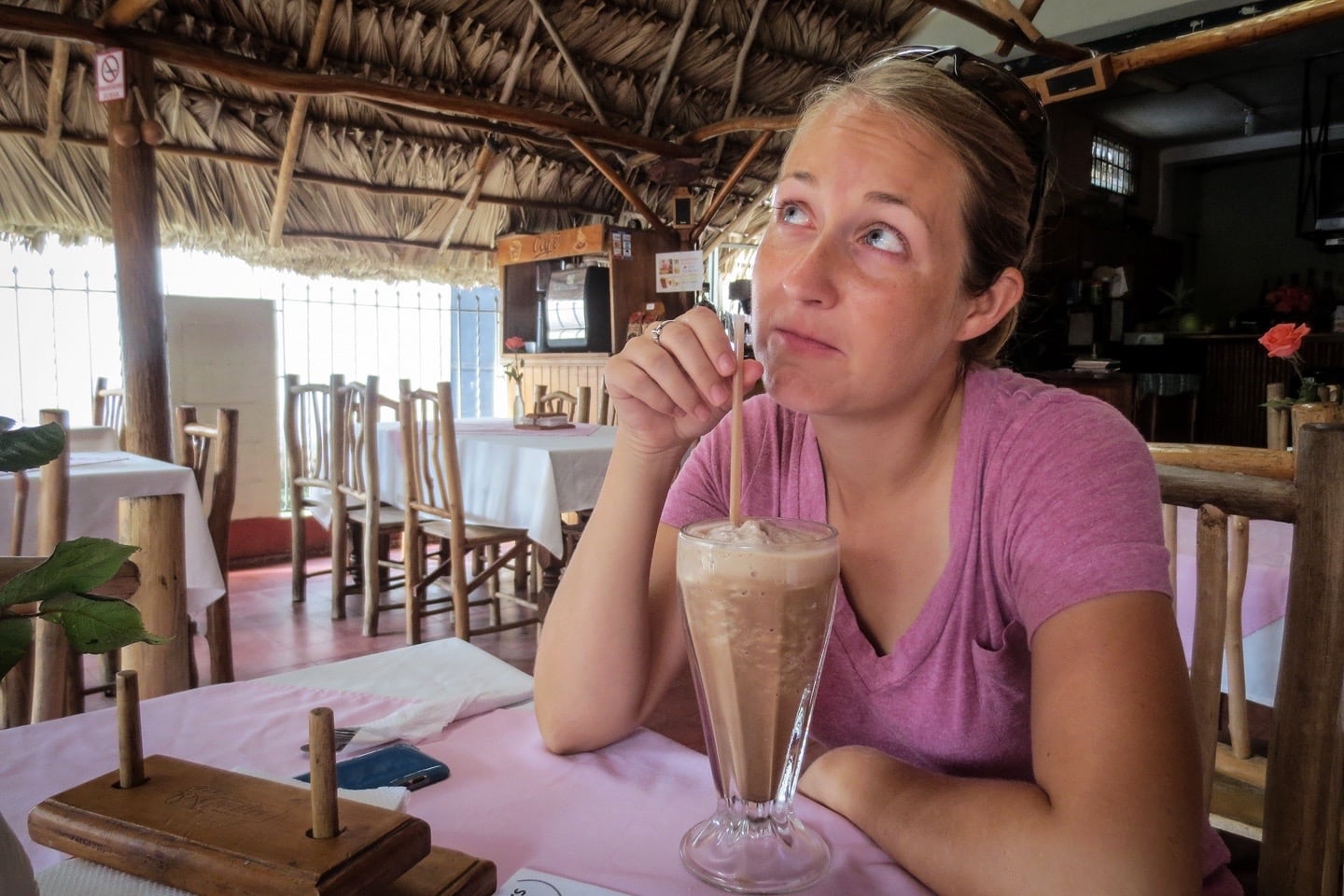
Lori sipping an iced frappuccino at Happy Fish.

Sipping Caipirinhas during happy hour at Happy Fish the night before (US$1.50 each!). Needless to say, we each had more than one…

…and some beers too, with ceviche at Buga Mama! Buga Mama is a bit pricey, but they serve food you just can’t get in PG (Thai food!) in addition to local favorites. And 100% of their profits go towards local education initiatives.

Lodging: Casa Rosada
[Above] Sunrise from Casa Rosada (Lori took this pic…I was still sleeping).
We stayed at Casa Rosada — which is a fantastic place — in one of the thatch bungalows, which we found clean and comfortable. All of the bungalows have screen windows and mosquito nets, but we didn’t see a single critter, and even didn’t use the net the first night. The only downside is that they don’t have en suite toilets/showers, but we got lucky as ours was right next to the bathroom, which was also very nice — tiled shower, hot water, tasteful decor. There was also a giant and friendly, if a bit forlorn-looking, toad outside our front step that greeted us each evening.
They’ve got a restaurant that serves up tasty food, but it is a little pricey and you have to tell the kitchen staff before 5pm if you want dinner (which is served at 7pm).


Casa Rosada is quiet and very laid back and cabanas are only US$20/night. It also has its own pier with a palapa (the thatched hut thing) on the end with three hammocks. The area is popular for swimming and catches a nice breeze.
My one big complaint with the place is that, while we had the guesthouse all to ourselves for the most part, a number of people, young and old, from the cheap backpackers down the street (I won’t name names, but it has the word “Iguana” in it…which by the way looks WAY nicer in their online photos than in person), would come by Casa Rosada every day that we were there, buy a drink or a small snack, and spend the ENTIRE day hogging every desirable piece of real estate on the grounds (and would essentially take over the hammock hut on the water), while paying guests like Lori and I were relegated to uncomfy chairs. I guess we would have made a bigger stink about it if we weren’t out and about enjoying the rest of the area, but it especially irked us when we’d get back in the evening and they’d still be there. I’d hate to see what sorts of clashes go down between guests and non-guest in the high season when both these places pack out…scratch that…I’d actually like to see that.


[Above] the highly sought after hammocks vacant at sunrise; [Below] View of the Livingston docks from Casa Rosada.

As mentioned above, we visited Livingston on a long three-day weekend: Pan-American Day weekend, in fact (which coincides with Columbus Day weekend in the U.S., though the two are not related).
When I was a federal employee, I thoroughly enjoyed my Monday off in October, but didn’t feel much inclined to celebrate Christopher Columbus (which is not his actual name, by the way, but an Anglicisation of Cristoforo Colombo, and it’s BS that Americans do this, I mean, Italians don’t call George Washington Giorgio Washingtonio, right? (if they even talk about him at all)). And by the way, Hawaii, South Dakota and Nevada don’t recognize Columbus Day, for various reasons — and our home state of Oregon used to not recognize it, but kind of does now (or not, I’m not up on my Oregon Columbus Day recognition news).
It seems quite a bit outmoded in 2013 to continue to celebrate a single man and his single “accomplishment” that is so enveloped in controversy and that ultimately led to the deaths of millions through war and disease and an extinction of an entire hemisphere’s rich cultural heritage and way of life. The fact that many people still use the word “discovery” and this guy’s name in the same sentence irks me to no end. I’m not hating on the U.S., I just tend to think that celebrating Pan-American Day, a day commemorating unity and our commonality as inhabitants of this great big piece of land stretching nearly from pole to pole is so much more enriching, right? but I digress…


Siete Altares & Playa Blanco
On Sunday, we hired a boat to take us to the seven waterfalls/pools of Siete Altares and then on to Playa Blanca (White Beach).

The second pool of Siete Altares.

Palapa constructed with the help of many soda drinkers.

The pools were beautiful, but the beach was the main attraction. It’s a stunning beach, even during the rainy season (now) when it gets a bit murky. I’ve seen pictures during the dry season and it is about as idyllic as it gets, clear/azure water lapping up on white sandy beaches fringed by coconut trees. Now you may say, ‘but wait! don’t you live in Belize, the land of sun and sea???’ to which I would reply, yes, we most certainly do, but white sands and clear waters aren’t the only things that make a good beach.
After years spent deep in the trenches, baking on wet and sandy expanses from the Gulf of Mexico to Eastern Africa, California to Southeast Asia, the Caribbean to Hawaii and so on, I consider myself something of an aficionado of fine beaches.
In my opinion, a good beach has to meet basic criteria:
■ Warm climate
■ Water temperature above 68°F (20°C)
■ Uncrowded
■ Relatively clean and free from detritus
■ And, well, it’s got to have some sand!

However, a GREAT beach has:
■ Hot climate, mostly blue skies
■ Water temperature above 78°F
■ See-your-feet crystal clear and calm waters (I don’t surf…)
■ Soft, powdery sand (I’m not particular about color, but white seems to do the trick)
■ Only a smattering of other people across a large area (completely deserted freaks me out a bit)
■ Not a speck of trash
■ Nearby shade (dense palm trees are preferred, but a thatch hut will suffice)
■ Hammocks, I love me some hammocks
■ A nice light breeze
■ A fresh water source to wash off in
■ A place from which to procure beverages, preferably of the alcoholic variety (e.g. cold beer, piña colada, coco loco)
■ A snack shack…
■ …yet at the same time, absence of hawkers (it’s ok if someone comes up asking to take a food/drink order, but for the love of Pedro, I’m not going to buy a handwoven basket or world map while I’m laying on the beach, even if I want one!
■ And sailboats in the distance…I like watching sailboats from my hammock.
Playa Blanca, surprisingly, met the vast majority of these criteria, and I was very pleased by this discovery. It was largely empty, but for a few other couples and a handful of locals who were there to collect fees, prepare food/beverages, fish and hopefully to enjoy themselves on a Sunday as well. PB has a wonderfully hot and sunny climate, warm water, soft sand, it’s pretty clean for being at the receiving end of the current coming down from Belize, along with…
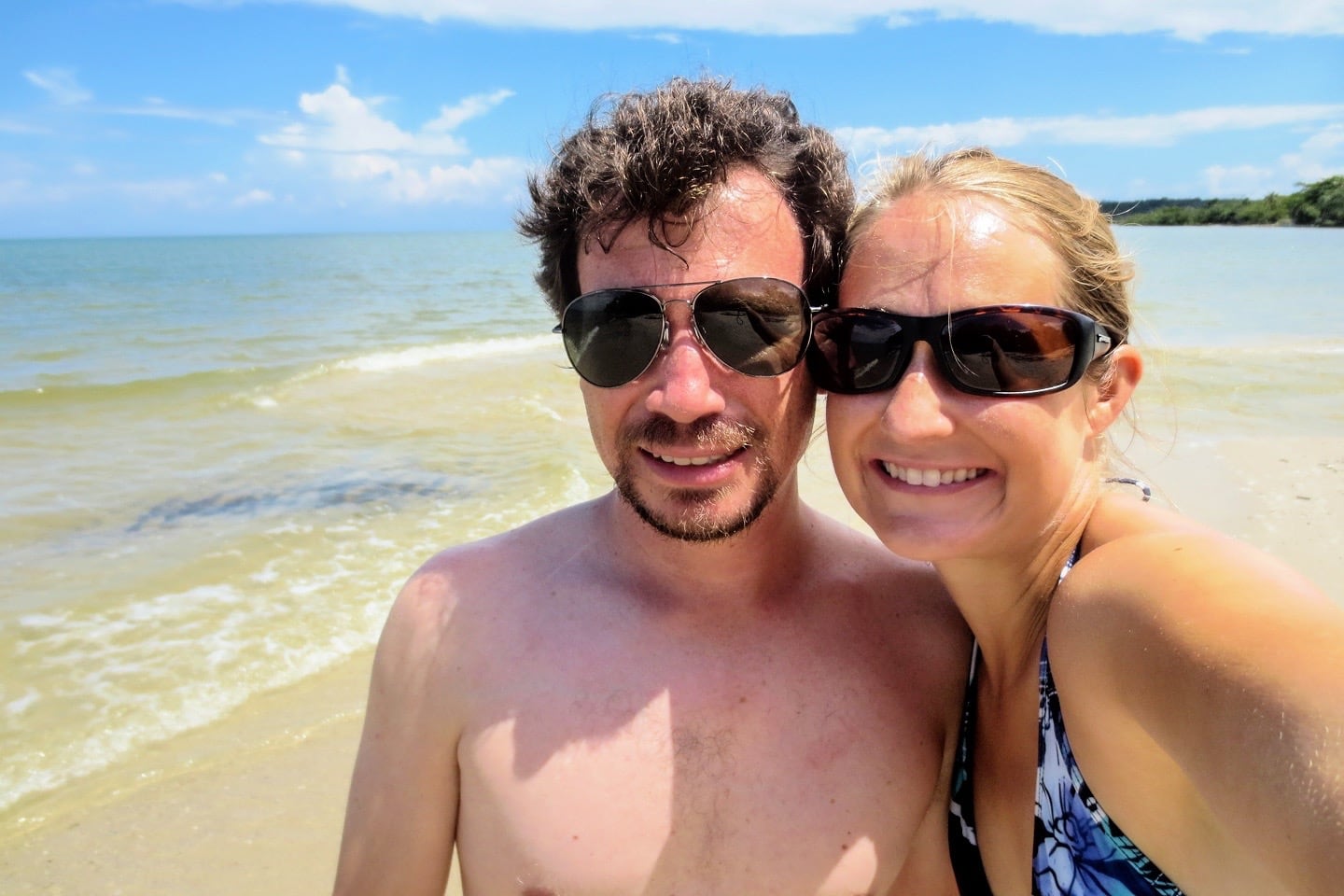
…good “selfie” photo-op spots…
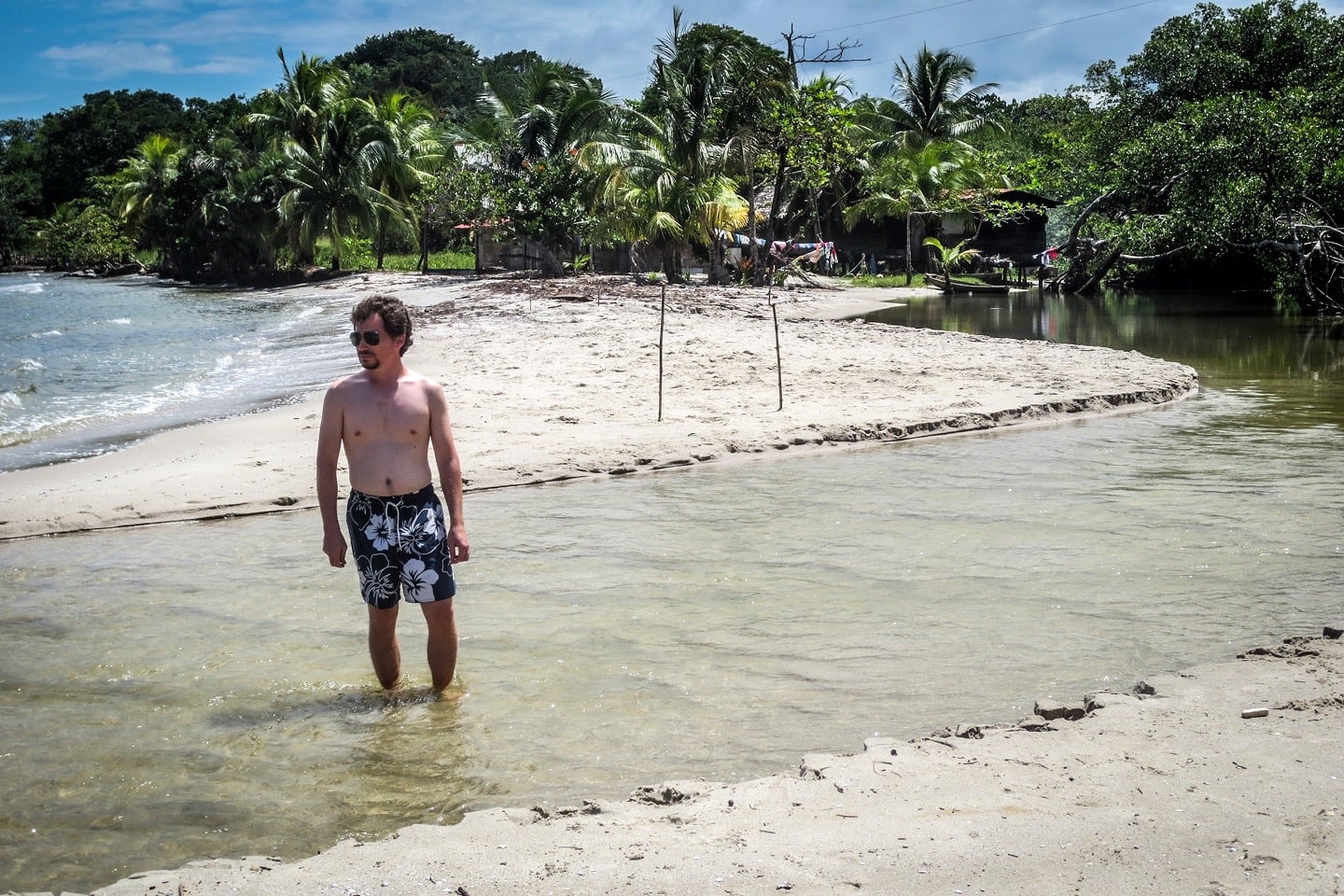
…awesome jungle-beach photo-shoot scenery (model not included)…

…Shade and Hammocks!…

…And more hammocks (with even a few passing sailboats in the distance)…

…COCO LOCO!!!…AND…

…A freshwater jungle shower with a coconut shower head…SCORE!
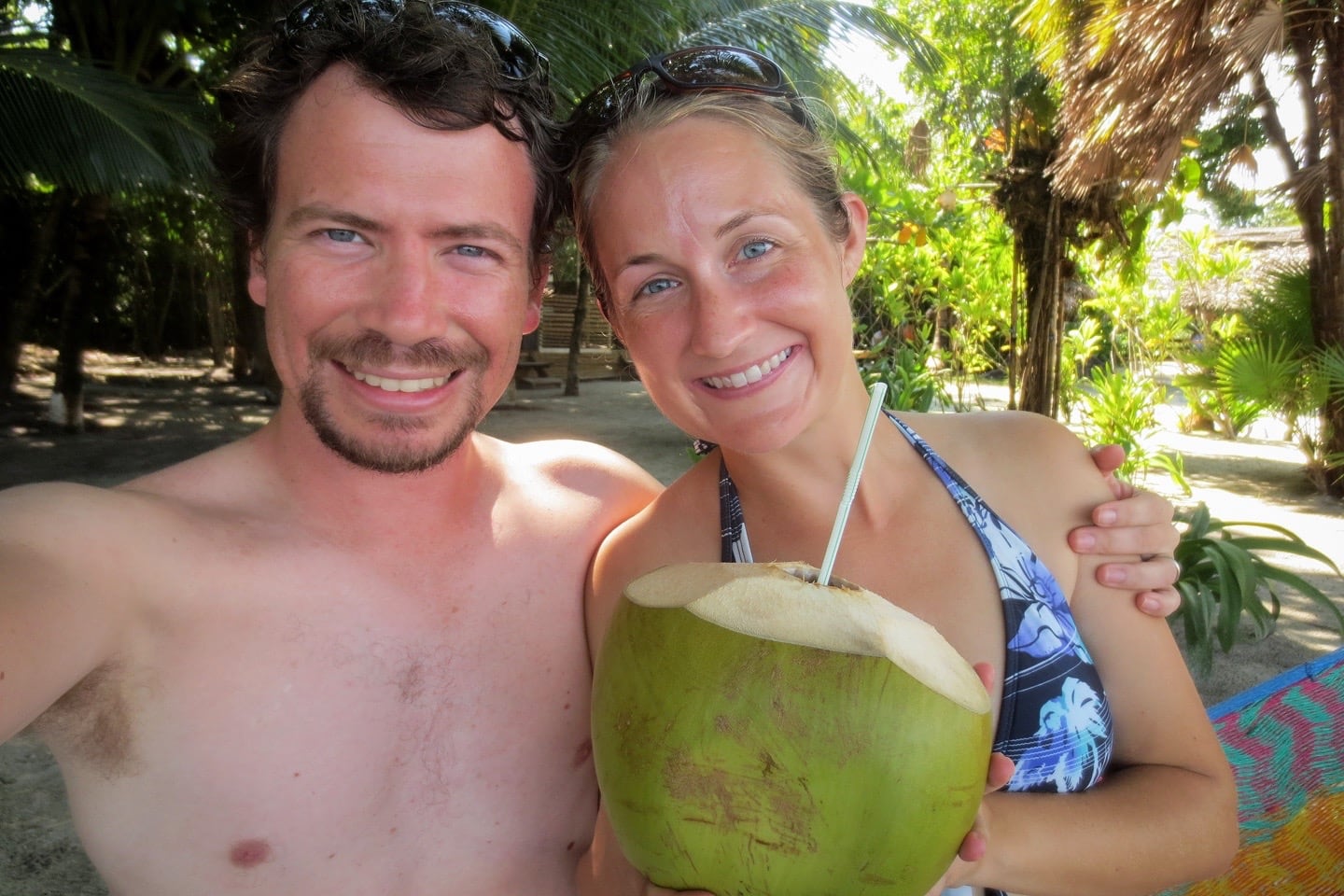

Welcome [back] to Belize!
Ha! You thought we were done here. Thought I’d leave you with one last photo of the mighty Port of Punta Gorda, our fair town! Here, they’re loading goods from Guatemala bound for the north. To the left is Customs and Immigration and to the right is, believe it or not, the Duty Free shop where our boat’s whiskey came from.



